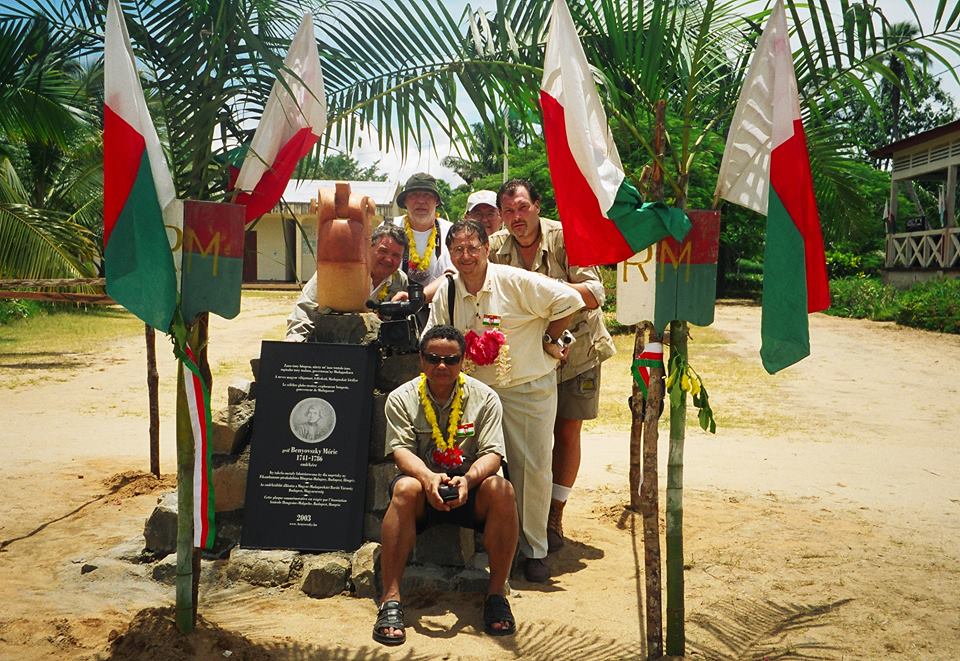Were there any Hungarian colonies in the world?

During the modern colonial era, Hungary was neither independent nor a great power to join other European countries in the race for new, seizable territories. However, during the era of the Austro-Hungarian Monarchy, there were some attempts and a couple of them were even successful. Interestingly, the Hungarian elite wanted the Empire to concentrate on Europe so they tried to block such attempts.
In fact, most of the times the Monarchy’s foreign horizon ended at the borders of Central-Europe and the Balkans; however, her explorers reached almost every part of the world and it happened sometimes that they claimed the land their set foot on for their country. Of course, there were many adventurers, as well, who tried to become kings or emperors and claimed that behind them there is at least an arsenal of soldiers (though invisible) and at least one great power like Austria.
One of them was Móric Benyovszky who reached the island of Madagascar at the end of the 18th century and claimed that locals elected him a king. Though the French king was not interested in the colonization of the island (later this changed and in the 19th century the island became a French colony), Benyovszky tried to convince Habsburg Empress Marie Theresa. Unfortunately, she refused to accept the offer so Benyovszky went to the USA and persuaded some traders to support him. However, when he returned to the island he was killed by the locals, but his tomb is visitable even today.

Banquibazar is an Indian town in the Ganges delta which was in the hands of the Habsburgs at the beginning of the 18th century; however, they lost it quickly. Today the town’s name is Icsapur and is one of the suburbs of Calcutta. In fact, the Habsburgs had another town, Cabelon (Covelong), in South India but they lost it to Sweden. Remaining in the region, Austria tried to acquire the Nicobar-islands near Indonesia in 1778, 1858 and 1886, but they were not successful against the British Empire. Furthermore, the Austro-Hungarian Monarchy tried to buy Socotra at the entrance of the Gulf of Aden in the 1880s for trade purposes; however, the British did not allow it, too.

The Monarchy tried to reach as many places as possible in the Pacific Ocean during the turn of the 19th/20th century and acquire nickel-rich lands. This happened in the Solomon Islands where even Miklós Horthy, the future governor of Hungary set foot in 1894 as a sailor of the Austro-Hungarian fleet. However, locals attacked the expedition and killed many of them in the next year.
In 1899, the weakening Spain tried to sell Western Sahara, and one of the potential buyers was the Monarchy. The Hungarian political elite opposed the plan until Madrid changed its mind so the transaction was killed. In the case of Franz Joseph land, the occupation happened in 1873. In fact, explorers lost their way on the Arctic Ocean and drifted to the island with the ice. When they reached it, they named it after their emperor and king. Furthermore, they named some of the islands after the sponsor of the expedition, Ödön Zichy. Since the territory was not acknowledged by any international bodies and strategically it was not important, the entente forgot to take it after WWI and it became part of the Soviet Union only in 1926. Today it is much more important since experts suspect large fields of gas and oil beneath the earth; however, they cannot extract it yet.

The Monarchy obtained its first real colony in China after the Boxer Rebellion in 1900. In Tianjin, they received 100 hectares of land on which they created a not too successful trade settlement. However, this was the only internationally acknowledged colony of the Monarchy where there was a regular ship run from Fiume (today Rijeka) in every three weeks. Today the town has 14 million inhabitants and Beijing can be reached from there in 27 minutes.
Apart from the above-mentioned examples, Fran Joseph (1848-1916) thought that he should occupy lands in the Balkans instead of on remote continents and islands. Therefore, they firstly obtained Bosnia and Herzegovina in 1878 and then tried to occupy Albania. In the latter case, Ferenc Nopcsa wanted to become Albanian king while Lajos Thallóczy was one of the fathers of the modern Albanian nation even though Vienna/Budapest could not turn the territory into their colony.
Featured image: Peace March for Hungary in 2012 – We will not be a colony. But were there any Hungarian colonies in the world?
Photos: facebook.com/Benyovszky-Móric-Társaság-Magyar-Madagaszkári-Társaság, commons.wikimedia.org
Source:





